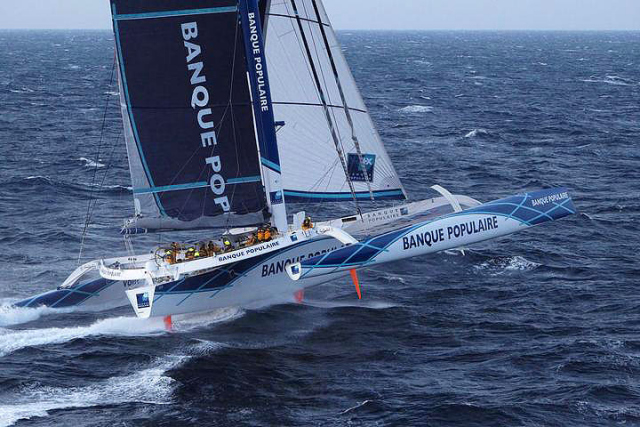 Den 13 man stora besättningen på 140 fots trimaranen Banque Populaire slog igår rekordet att segla non-stop runt jorden. Det nya rekordet lyder 45 dagar, 13 timmar och 42 minuter, nästan tre dygn snabbare än tidigare rekordet.
Den 13 man stora besättningen på 140 fots trimaranen Banque Populaire slog igår rekordet att segla non-stop runt jorden. Det nya rekordet lyder 45 dagar, 13 timmar och 42 minuter, nästan tre dygn snabbare än tidigare rekordet.
Båten gick i mål mellan engelska Lizard Point och franska Ousant. Rekordet går under namnet Jules Verne efter en fransk författare, och går ut på att segla non-stop runt jorden utan assistans från land och utan hjälp av hydrauliska eller elektriska vinshcar.
År 1993 klarade flerskrovslegendaren Bruno Peyron sträckan på 79 dagar 6 timmar och 15 minuter med en 86 fot lång katamaran. Sedan dess har rekordet slagits sex gånger. Sist i ordningen var Franck Cammas, nu skeppare i
Volvo Ocean Race, år 2010 med sin 103 fot långa Groupama 3. Nu har Brunos lillebror Loïck Peyron tagit rekordet med sin enorma trimaran god för farter kring 50 knop! Ett fantastiskt rekord och en enorm triumf för Loïck som försökte slå rekordet förra året men blev tvungen att bryta.

Banque Populaire har haft en otrolig resa där de oftast legat långt före den tidigare rekordinnehavaren (se video i botten av artikeln som visar de båda båtarnas spår runt jorden).
De har gått så långt som 62 grader syd vilket är lite av en självmordsakt då man löper stor risk att krocka med isberg. Förödande för en båt som ofta har en snittfart på osannolika 40 knop.
Upplevelsen att segla Banque Populaire liknar ingenting. I fjol fick jag möjligheten att segla Thomas Covilles rekordtrimaran för ensamsegling, 105-fotaren ”Sodebo”. Vi seglade en kort bit längs frankrikes kust i cirka 30 knop, fantastiskt stabilt och helt odramatiskt. Banque Populaire spelar i en annan liga… (se hamnen.se-videon från Sodebo).
“I was so happy. It’s my fourth time around the world non-stop, this has been the best, on the fastest boat in the world”, säger Brian Thompson till BBC och fortsätter:”It was the trip of a lifetime, we saw some amazing sights, icebergs, comets and albatross, but I am very glad to be back on land.” Från Ushant till ekvatorn på 5 dygn, 14 tim och 55 minutter.
Från Ekvatorn till Goda Hoppsudden på 6 dygn, 6 tim och 53 minuter Från Kap Horn til ekvatorn på 7 dygn, 5 tim och 0 minuter.
Det mesta som skrivs om Jules Verne är på franska men en av seglarna, brittiske Brian Thompson, har bloggat på engelska hela varvet runt. Läs mer här: brianthompsonsailing.blogspot.com
Här följer hans senaste uppdatering:

“Jean Baptiste came on deck this morning and said to us “fast, but not furious”, and that’s been our mantra. Despite doing outstanding speeds the last 2 days we have not been furious, always been in control..The conditions have just been great with small seas and winds of 25-30 knots..we have been changing between the solent and small gennaker, and between one and two reefs in the main..
Top speed that I did on my last watch was 43.6! That’s the fastest I will get to till the finish, as the wind will dropslowly..it might well have been my last full on blast on this mighty machine..
However much we want to get to the finish, to accomplish the goal, to lift the stress of going this fast for so long, to see family and friends, to do other things than live in a carbon tunnel. There is part of you, a small but valid one that is sad to see it ending – could this be the best trip of a lifetime?
So am enjoying these last miles, these last hours as we blast past Ireland, the Scillies and onwards to the finish..
This afternoon has been busy, and like seeing the first jet contrails, the first fishing boats, we are experiencing the first signs of approaching civilisation, of reengagement with the land world..
At 1100 we had a satellite being guided to sit overhead to take picture, at 1300 a French navy/coastguard jet, a Falcon 50, from our boat’s home port of Lorient, came to take video..At 1500 we will get a call from the President of France…
It’s all going on here!
ETA 2200 to midnight tonight. One last watch to go..and I think our lucky watch streak is going to continue, with having the start, finish and most of the major Capes during our time on deck..
Now with on reef and medium gennaker the wind is starting to drop a little.
We are having the most unorthodox arrival at the finish line – from the North. We almost certainly have now gone the furthest North (52N) and furthest South (62S) of any Jules Verne attempt..”

